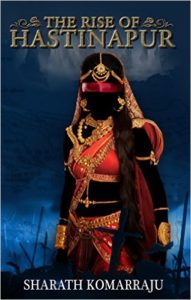Review of The Rise of Hastinapur by Sharath Komarraju
Re-imagination of the longest epic poem in world, Mahabharata, is a daunting task. Not only the author runs the risk of offending the loyal fan of epic (and the religious fundamentalists) but have to add enough novelty to the story to keep readers interested, always keeping their eyes on big picture of the epic: 18 days war. The author has to view the epic from a previously unused angle (like looking through the prism of female characters), use new plot points (taking threads of epic or use his/her imagination), and build a new world for characters to inhabit in order to push characters to their edge (taking help of geographical location of old world). This new retelling of epic tale Mahabharata: The Rise of Hastinapur, is a special one because Mr. Sharath Komarraju views the epic (or a part of epic) through matriarchal lens, in contrast to patriarchal lens, which had been used several times overs in TV serials or books written through the point of views of major male characters of epic (Arjuna, Yudhisthar, Bhima, Karana etc). This book is actually a collection of three novellas about three important female characters of Mahabharata: Amba, Kunti (Pritha), and Gandhari. The author reimagines the childhood of these female characters and fuels their adult life with rabid desires to bring out their distinctly grey personalities. Sex or sexual undertone is threaded through these stories, not always as the driving force but as a mean to satisfy wants/desires of female characters. Writers or makers of Hate Story Franchise should take notice of such a rich heritage we have.
The book is hard to put down in first (Amba) and third part (Gandhari). Even though the second part (The Black Stone) is richly imagined and intricately plotted story, it drags because it takes too long to reach to the conclusion. I could give following explanations: the story started out as Devaki/Kamas story and turns into Pritha’s story, the story takes too long to return to Mathuram takes too long time to explain the importance of Black Stone, or too many characters in this story (Nabha, first priest, and High priest). Also, Durvasa/Surya love angle with Pritha didn’t have enough steam to sustain the story for so long.
Overall, this is a fascinating book on Mahabharata told passionately through female characters. If you have ever wondered while watching/reading Mahabharata what Amba went through after she left hastinapur, if you want to know how Prita (Kunti) gave birth to Karna, and why Gandhari chose to marry Dritrashtra, this book will not only answer your questions but also make you think, “Oh! That’s why they did this.”
Here is the link on Amazon
http://www.amazon.in/gp/customer-reviews/R3ERKOP1WJ2SPM/ref=cm_cr_pr_rvw_ttl?ie=UTF8&ASIN=9351773760
